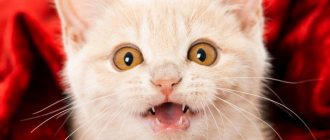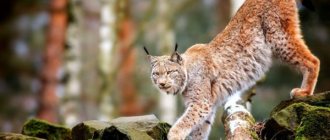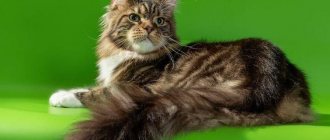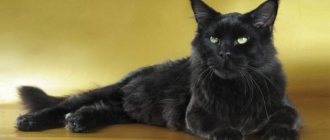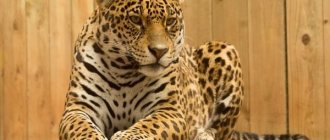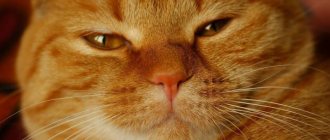Save article:
Why do some people like big cars, while others are happy with small models? Some feel comfortable in small, cozy apartments, but there are people who do not recognize tiny spaces. Psychologists probably have explanations for everything, including why some owners have not just cute cats, but big cat breeds
.
It’s easy to imagine a miniature pussy in the house, but what if such a purr weighs 7 kg or more? Large domestic cats fit very harmoniously into the home interior, looking regal and graceful. Such animals are much more reminiscent of their wild relatives and force one to reckon with their feline character.
Felinologists have done their best in breeding domestic big cats of different breeds, and we can introduce you to the largest representatives of felines.
Savannah
This animal amazes others with many of its characteristics, namely height, weight, etc. But the main surprise awaits those who decide to buy a kitten of this breed for themselves. The price is truly astronomical, although it is due to the fact that this breed has only 1 thousand individuals, and the first offspring were born only in the spring of 1986.
The basis of this breed was the domestic cat and the wild African serval. As a result, an animal was born, distinguished by its unique color, large ears, long legs, as well as fantastic jumping ability (up to 3 meters) and love for the water element. Savannah not only loves to swim, she is an excellent swimmer and is able to cover enormous distances across the surface of the water.
In addition, the Savannah has a developed intellect, she has an easy-going character and is devoted to her owner.
Features of keeping giant cats
Large pets require special conditions. They need more food and exercise. Otherwise, their health may suffer.
Feeding
Avoid two things: overfeeding and mono-feeding. Animals reach their maximum weight only by 3-4 years, so there is no need to contribute to its gain ahead of time. In this case, instead of a muscular and graceful cat, you will have a bun that moves with difficulty.
When calculating daily caloric intake, be guided by the average recommendations, but be sure to adjust them to suit your pet through observations. The higher the activity, the more food is required. An insufficient amount of food can be easily tracked by weight loss, so do not forget about periodic weighing.
Don't feed your cat only meat. Animal proteins are healthy and nutritious, but such a diet may result in a deficiency of calcium and other important elements. In addition to them, the diet should contain:
- fats (sea fish, flaxseed);
- carbohydrates (zucchini, apples, oatmeal);
- sprouted oats and brewer's yeast.
On a natural basis, it is recommended to add vitamins to food. They are selected by a veterinarian based on tests.
Large animals often suffer from diseases of the musculoskeletal system. If your pet eats dry food, take him food with chondroprotectors that improve the functionality of the joints.
Predisposition to disease
Heavy weight puts a lot of stress on bones and joints, so first of all you should be wary of arthritis and dysplasia. In addition to proper nutrition, prevention includes mandatory observation by a veterinarian. A predisposition to joint pathologies is usually inherited, so be sure to check information about the kitten’s parents before purchasing it.
All other ailments depend not on the size of the cat, but on its breed. Maine Coons are prone to diseases of the urinary system, Siberians - to food allergies, Ragdolls - to cardiovascular diseases, and Chausies - to digestive disorders.
If you decide to purchase a purebred pet, study detailed information about the features of its maintenance and care. This will allow you to adequately assess the risks and compare them with your capabilities.
Do you like the article? 0
Maine Coon
This breed rightfully takes second place in the list of the largest cat breeds. Representatives of this breed have a weight of about 15 kilograms and a rather menacing appearance. At the same time, they find a “common language” with both adults and children, without offending pets either.
These animals have a characteristic color and a powerful tail, like raccoons. Thanks to these features, the name appeared, which translated means “Mensky raccoon”. Maine is the name of the state in the United States where the ancestors of Maine Coons were once kept on farms.
The breed is practically devoid of disadvantages, with the exception of its astronomical cost. Cats are easy to train and always demonstrate nobility, intelligence, calm disposition and grace.
10 ABNORMALLY BIG CATS IN THE WORLD
Interesting Facts
The biggest cats also include the fattest. According to the Guinness Book of Records, today this title is awarded to the cat SpongeBob, who weighs 15 kg. The pet is currently on a diet. And in general, the founders of the book decided to remove this category from great achievements, so that cat owners would not try to become famous at the expense of the health of their pets.
Throughout the history of records, the prize has been awarded several times, and according to its statistics, the fattest was an Australian cat named Khimiya, whose weight was more than 21 kg. The poor guy died from obesity and related diseases.
Having the biggest cat in your personal possession is not the greatest achievement. Yes, size matters, but love for your pet should come first.
Let's watch a video from the Nat Geo channel about another of the biggest and fattest cats in the world, named Meow:
Chausie
It is considered not only one of the largest, but, at the same time, the rarest breed, the weight of which can reach at least 14 and a half kilograms.
The breed was born in 1990 and is a hybrid of an Abyssinian cat and a jungle cat. The jungle cat prefers to live in swamps, which is why it is also called the swamp lynx.
As a result of hard work, breeders managed to get a cat that has the power of a predator and the docile nature of a domestic cat. Chausie cats are quite strong cats, with an athletically complex body, a large (comparatively) head, large ears, and green or yellow eyes. Despite such external characteristics, the breed is devoted to its owner and feels great around children.
Neva Masquerade
Representatives of this breed have a muscular body and a wide chest. Large ears, bent slightly forward. There are always characteristic brushes at their ends. Almost the only feature that distinguishes the Neva from its Siberian cousins is their coloring.
Characterized by a soft coat (semi-long, close-lying and waterproof, which provides effective protection from cold and moisture) and a long fluffy tail. Neva masquerade kittens are born completely white and only acquire their colors with age.
Friendly animals, without any tendency towards aggression. They easily come into contact with people and become very attached to them. They can find something to do even when they are alone at home. But they usually love company, easily settle into a human family, they get along well with other cats, and can also be friends with dogs.
Neva Masquerades are not aggressive, they like to play and patiently endure all kinds of affection, so they get along well with children.
| Neva Masquerade breed size chart | |||
| Height at withers (cm) | Body length | Weight, kg) | |
| Cat | 33 | 100 | 9 |
| Cat | 30 | 90 | 8 |
| Kitten (3 months) | 1,8 |
If a cat is let out of the house, it will hunt, but this is not the basis of its feeding. It should be remembered that he is by nature a predator and a meat eater, which means that the basis of his diet should be meat
And very important - adult cats do not drink milk. Not only do they not need it, but it is not even practical for them
Babies gain weight easily.
Ragamuffin
California is considered the birthplace of this breed, and it was born as a result of the efforts of Ann Baker, who decided to modify the Ragdoll. So she began to crossbreed the Ragdoll with other cat breeds, such as the Persian, the Yard Longhair, and the Himalayan.
As a result of these efforts, a breed was born that was called “cherub,” but at the last moment it was renamed and began to be called “ragamuffin,” which means “ragamuffin.”
Adults weigh at least 10 kilograms and acquire impressive sizes, although they mature only at 4 years of age. The breed does not have a beautiful, proportional physique, but it is distinguished by a variety of coat colors.
Ragdoll
This is a breed obtained through selection in the 20th century. Breeder: Ann Baker from California, USA. The breed was registered in 2000. Known for her flexible character.
View this post on Instagram
A post shared by Victor Ray (@v1cr4v)
The name comes from the habit of relaxing. The pet purring in your arms sags, resembling a rag doll. It is believed that the observed flexibility of the cat is associated with a genetic disorder. Height at withers – 30–40 cm. Weight – 7–12 kg.
Kurilian Bobtail
The list of the largest cat breeds is replenished with another giant, since adult individuals can weigh at least 7 kilograms.
This breed of cats was once moved from the Kuril Islands to the mainland at the end of the last century.
The breed is distinguished by the original shape of its tail, which is quite short (only 8 cm maximum) and somewhat resembles a pom-pom. If a cat of this breed has a tail longer than 8 cm, then this is considered a fault of the individual, and if its length is only 12 cm, then the cat can be removed from the competition.
Kuril bobtails are not afraid of either moisture or frost, although they do not like to swim, but at the same time they are excellent at hunting fish.
The behavior of this breed of cat is somewhat reminiscent of the behavior of dogs, since they are very curious, are highly active and never refuse long walks and fun games, involving various toys, where they carry them in their owner’s teeth, like dogs.
Fourth place – Leopard (Panthera pardus)
Leopard
The fourth largest among wild cats is the leopard. There are 9 subspecies of leopard (African, Indian, Javan, Arabian, Anatolian, Amur, Indochinese, Sri Lankan), which are found in Africa, East and South Asia. These cats live in tropical forests, deserts, savannas, grasslands, mountains, coastal areas, scrub and swampy areas.
Interesting: The most popular domestic rodents - list, name, description, photo and video
Leopards spend a lot of time in trees and are active mainly at night. Leopards have a muscular, flexible body, they run at a speed of 60 km/h, and jump 6 meters in length and 3 in height. Like pumas, leopards are solitary, territorial, predatory animals. Leopards roar, growl, meow. Their roar is associated with the spraying of wood.
Leopard fur color ranges from pale yellow to tan or gold. There are dark spots on the body, which are called “rosettes” because they are shaped like a rose. Males are larger and heavier than females: 40-90 kg versus 30-60 kg .
Leopards are endangered. The rarest subspecies, the Amur leopard, is found in the Far East, Korea and northeast China, with only 30 individuals in the wild. The average lifespan is 12-17 years in the wild and up to 23 years in zoos.
Norwegian Forest Cat
Due to the fact that the forest cat has long, fluffy fur, it seems that this animal is quite large. In fact, adults generally weigh no more than 9 kilograms.
There is a legend that this breed of cats was brought to Scandinavia by the Vikings in the holds of their ships. What these cats did on ships was to catch rodents, saving sailors from hunger and the bubonic plague, which was spread by rats.
In northern latitudes, cats became slightly domesticated, beginning to live next to humans. In 1934, the stage of breeding work with the Norwegian Forest Cat began, for which purebred representatives of this breed were sought throughout the world, as well as throughout the country. In 1976, the breed was officially recognized throughout the world.
The Norwegian cat is distinguished by its stable psyche; in addition, it is brave and strong, with the skills of a real hunter. These cats are not afraid to be with dogs that have the same easy-going nature, or near children. The Norwegian Forest Cat is considered to be one of the smartest.
Turkish van
The ancestors of the Turkish Van are aboriginal semi-long-haired cats, who from time immemorial lived in the area adjacent to Lake Van, located in Turkey. This breed was discovered in the modern world by British journalist Laura Lushington, a big cat lover. From her trips to this region of Turkey in the 50s of the last century, she several times brought charming kittens, with which the breeding of the Turkish Van cat breed in Europe began. Today, the Turkish Van is recognized by all leading felinological international organizations.
An adult Turkish Van cat can weigh up to 9 kg. His body is muscular, long, with a wide, powerful chest. These pets love water fun and swim well. They are very active, sociable, overly inquisitive and emotional. They have a well-developed hunting instinct. In childhood and adolescence, these cats can even show some aggressiveness, biting and scratching their owners. However, with age their character becomes softer.
In Turkey, aboriginal Van cats (they are called van kedisi here) are very revered, are one of the symbols of the country and are listed in the Red Book. They are credited with the gift of bringing happiness and good luck; these animals are even allowed to enter the mosque. It is possible to export Turkish Vans from the country only with official permission.
Turkish van
Siberian cat
According to some experts, the Norwegian cat and the Siberian cat have common ancestors. Despite this, the Siberian cat is distinguished by both intelligence and intelligence. Moreover, its weight can reach 12 kilograms.
These cats grew and developed in the conditions of the Far Eastern taiga, so they are absolutely fearless animals that are not afraid of their natural enemies.
The Siberian cat is not only smart, but also beautiful, and also not spoiled by selective artificial selection. She is an excellent example of a real hunter, as she is able to hunt even hares.
The Siberian cat has a calm and balanced disposition, which helps her find a “common language” with both adults and children. At the same time, she will easily show who is “the boss”, regardless of who is in front of her, a cat or a dog.
Chartreuse
The ancestors of the Chartreuse are unknown. But felinologists associate the appearance of the breed with the Crusaders and the Order of the Carthusians. Chartreuses accompanied ships to Africa, saving ship supplies from rodents.
View this post on Instagram
A post shared by Victor Ray (@v1cr4v)
The cat has 2 features. First of all, there is a pronounced hunter’s instinct. Therefore, the animal is not recommended to live together with rodents and birds. Another feature is long-term growth. The pet grows up to 5 years. The height of an adult Chartreux is 30 cm, weight is 7–9 kg for a male and 4–5 kg for a female.
British Shorthair
Thanks to its powerful body and short hair, it seems that this is a huge, strong cat, although in fact males weigh no more than 9 kilograms, and females - 6 kilograms.
The breed has an independent character and does not like pleasantries. She is able to endure prolonged loneliness, although she loves her owner very much and misses him if he is not at home. Because of its unobtrusiveness, it received a second name - “cat for a businessman.” He is wary of strangers and does not let them get closer than a couple of meters to him. If he wants, he can easily catch a rodent.
They accept affection only when they want it themselves, while demonstrating a sense of self-worth.
Lil Bub
One of the most famous cats in the world. Lil Bub became famous thanks to the Internet and her unusual appearance. Osteoporosis and genetic mutations are to blame. She had difficulty walking, and her appearance often became the object of increased attention. Lil Bub had an unusual muzzle structure; she had no teeth, which is why her tongue was constantly sticking out. This cat did not live a very long life (2011 – 2019), but it was a happy one. Her owner, Mike Bridavsky, loved his pet very much. He used the cat's characteristics for good purposes.
Throughout her life, Lil collected about 700 thousand dollars, all of which were donated to the fund to fight rare animal diseases. Lil Bub starred in the film and became a real star. Her Instagram account has about 2.5 million followers.
Pixie bob
This cat breed is considered a national treasure of the United States and its export is prohibited by law.
The breed was bred artificially. The breeders' task was to obtain a forest lynx that was not at all large in size. All that remains of the lynx are the tassels on the ears and unique colors, as well as a short tail. Adults weigh from 5 to 8 kilograms.
Despite the presence of lynx genes, these cats are distinguished by their calmness and love for their owner.
Chausi, 6–12 kg
Chausie is included in the list of the most exotic and expensive breeds. A miniature copy of a wild cat can become a worthy companion and will fall into the soul of even the most avid dog lover.
Chausi miraculously combine sociability and independence, which additionally gives them charm. Unlike most cats, representatives of this interesting breed love water, so you shouldn’t be surprised if the cat willingly creates splashes in the bathroom - it makes her happy!
Chausie is an extravagant cat that is highly trainable due to its desire to learn something new and its developed intelligence.
Main representatives
Let's find out how much the world's largest domestic cats weigh and how they differ in character.
Maine Coon
The most common of the large breeds. It was named after the state of Maine (USA), in which it appeared. The direct ancestors of Maine Coons are forest cats, fed by people to protect crops from rodents.
These cats look very impressive due to their long hair, powerful paws and “lynx” tufts on their ears. The weight of females is 7–9 kg, males – from 9 to 11 kg. Neutered cats can weigh up to 15 kg.
In addition to their beauty, these giants are valued for their intelligence, affection and good nature. They love company, are ready to follow on the heels of the owner and, to the extent they understand, even help him, for example, by giving objects. Easy to leash train. They treat things with care and are not prone to destructive behavior. They love water and often want to get into the shower with their owner.
Chausie
The result of crossing Abyssinian and wild reed cats (swamp lynxes). Selection is still ongoing. Animals with 50% “free blood” are labeled F1, 25% – F2, and so on until F5 (3.12% wild blood). F1s are the most valued.
The average weight of a chausie reaches 15 kg. The coat is short, but very dense and elastic.
These huge cats have a friendly and mischievous disposition. Very strong and agile, tend to climb high furniture, prone to mischief (often destructive without training). They are smart and quick-witted, love to learn new tricks and store supplies in secluded places. They can be kept in a private house with an aviary.
Chausie is one of the five most expensive breeds.
Kurilian Bobtail
The breed was brought from the Kuril Islands. Females weigh 3.5–5 kg, males – up to 7.5 kg. An interesting feature of the breed is its short (3–8 cm) tail, which looks like a pom-pom.
These are kind, smart, curious and active cats.
They quickly become attached to their owners and love attention. They can learn a number of commands and often, on their own initiative, bring things thrown to them
Ragamuffin
The result of a planned cross between Redheads and outbred cats. In honor of the latter, they began to be called ragamuffins (“ragamuffins”). Females weigh 5–7 kg, males – from 7 to 10 kg.
Ragamuffins have a very gentle disposition. They love to sit in their arms and willingly allow themselves to be hugged and squeezed. They do not tolerate loneliness well. They are playful, easily learn commands and get used to a leash.
Norwegian Forest Cat
According to legend, these cats were domesticated by the Vikings. “Norwegians” weigh from 5 to 9 kg, but thanks to their thick fur they appear larger. It forms a fluffy collar on the neck.
Smart and curious. Good-natured, but independent: they regularly need solitude and are reluctant to be held. Brave and curious, they love active games.
Top articles: How deadly are hippos?
Siberian cat
Domesticated forest cats of Siberia. Females weigh up to 8 kg, especially large and heavy males - up to 12 kg. The coat is long, thick, with a thick undercoat.
Independent, prone to dominance. Usually they become attached to one owner. A predatory disposition is combined with strength and agility: when free-range in the countryside, they can even bring wild rabbits as a gift to “their man.”
Chartreuse
One of the oldest European breeds. According to some sources, they are descendants of Egyptian cats and Pallas' cats. Females weigh up to 5 kg, males – up to 7 kg. The coat is short, rather dense, gray-blue.
They are smart, affectionate, but rather restrained in expressing feelings. They almost never meow, they only purr. They tolerate loneliness well.
Serval
A wild animal that has only recently been tamed. The record holder of this review: a male can weigh up to 18 kg. The coat is short, the color resembles leopard.
A kitten born in captivity will be an affectionate and friendly pet. Servals are smart, curious, good with people, but need their own safe shelter.
Very active and energetic. Due to their gigantic size, they are not suitable for apartments. The best choice for them would be a private house with an adjacent enclosure.
With patience and persistence from their owners, servals learn a number of commands and walking on a leash.
A serval born in the wild or in an unreliable nursery is life-threatening. This breed is strictly not recommended for families with small children in any case.
Turkish van
The homeland of these cats is the vicinity of Lake Van (Türkiye). Average weight – from 4.5 to 9 kg. The eyes of representatives of this breed are often multi-colored. The coat is semi-long, almost without undercoat.
They have a gentle and loving character and are usually friendly with other animals. Quite patient with children. They love active games, sometimes performing amazing somersaults when they catch things thrown to them in the air.
Well-fed Elvis
The cat's owners are currently trying their best to help him cope with excess weight. Elvis is given insulin injections twice a day and has also been prescribed a special diet to lose weight. They say that with the help of thoughtful nutrition, the gray and white cat got rid of 1 kilogram and continues to lose weight.
Now Elvis is considered “the fattest cat in Germany.” But according to the volunteers who took care of the animal’s health, this cat may receive the title of “the fattest cat in the world.” His weight, even after losing weight, remains greater than that of the cat, which is now recorded as “the fattest in the world” in the Guinness Book of Records.
Guinness Book of Records record holders
There are many large cats that are record holders worthy of inclusion in the Guinness World Records Book.
Among them is the world's largest domestic cat, the Maine Coon. By the time they reach adulthood (Maine Coons mature at the age of five), Stewie, which is the name of the pet, has grown to 1 meter 23 cm and 19 mm from nose to tip of tail
This record was included in the Guinness Book after neighbors and friends of the owners often began to pay attention to the enormous size of the pet. Stewie also has the world's longest tail among domestic cats.
Its length is 415 mm, while the average length of this process in cats is about 300 mm.
One of the longest cats is also registered in Russia, whose total length is 1 m 20 cm. A Maine Coon cat nicknamed Pinochet lives in Novosibirsk and is the unofficial record holder. One of the loudest cats on the planet is the British Smokey, owned by the Adams family.
The Maine Coon cat Missy boasts the longest mustache on earth among domestic cats. This beautiful cat lives in Finland, and amazes others with whiskers 190 mm long (on average, the length of whiskers in cats reaches 70 mm). The Savannah cat Island Trouble, who lives in one of the states of America, was recently recognized as the tallest representative of domestic cats. His height at the withers reached 483 mm.
One of the longest-living cats today is the Maine Coon cat named Rubble, who lives in the UK. He was born in 1988, and according to unverified information, he is still alive today.
